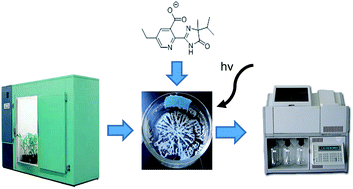Statistical analysis of the photodegradation of imazethapyr on the surface of extracted soybean (Glycine max) and corn (Zea mays) epicuticular waxes†
Abstract
The photodegradation rate of the herbicide imazethapyr on epicuticular waxes of soybean and corn plants was investigated. Plant age, relative humidity, temperature, and number of light banks were varied during plant growth, analyzed statistically, and examined to determine if these factors had an effect on the photodegradation of imazethapyr. Through ultraviolet/visible (UV-Vis) and fluorescence spectroscopy, epicuticular wax characteristics of soybean and corn plants were explored, were used to confirm observations determined statistically, and explain correlations between the rate constants and the composition of the epicuticular waxes. Plant age, the interaction between plant age and light, and the quadratic dependence on temperature were all determined to have a significant impact on the photodegradation rate of imazethapyr on the epicuticular waxes of soybean plants. As for the photodegradation rate on the epicuticular waxes of corn plants, the number of light banks used during growing and temperature were significant factors.


 Please wait while we load your content...
Please wait while we load your content...